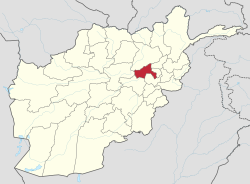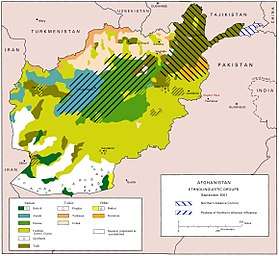Parwan Province
Parwān (Persian/Pashto: پروان), also spelled Parvān, is one of the 34 provinces of Afghanistan. It has a population of about 631,600,[1] which is multi-ethnic and mostly a rural society. The province is divided into ten districts. The town of Charikar serves as the provincial capital. The province is located north of Kabul Province and south of Baghlan Province, west of Panjshir Province and Kapisa Province, and east of Wardak Province and Bamyan Province.
Parwan پروان | |
|---|---|
 The Salang Pass during winter | |
 Map of Afghanistan with Parwan highlighted | |
| Coordinates (Capital): 35.0°N 69.0°E | |
| Country | |
| Capital | Charikar |
| Government | |
| • Governor | Mohammad Asim Asim |
| Area | |
| • Total | 5,974 km2 (2,307 sq mi) |
| Population (2015)[1] | |
| • Total | 664,502 |
| • Density | 110/km2 (290/sq mi) |
| Time zone | UTC+4:30 (Afghanistan Time) |
| ISO 3166 code | AF-PAR |
| Main languages | Dari and Pashto[2] |
The name Parwan is also attributed to a town, the exact location of which is now unknown, that supposedly existed during prehistory, in the nearby Hindu Kush mountains.[3]
Despite a four decade-long state of war in Afghanistan, Parwan was relatively free of conflict by the mid-2010s. While occasional attacks on government or international forces are reported, they are usually minor. Such incidents in Parwan mostly involve grenade attacks on the residences of government officials or roadside bombs.[4] Bagram Air Base, which is one of the largest US military bases in Afghanistan, is located in Parwan.
History
In 329 BC, Alexander the Great founded the settlement of Parwan as his Alexandria of the Caucasus. It was conquered by Arab Muslims in 792 AD.[3] In 1221, the province was the site of the battle between the invading Mongols, led by Genghis Khan, and the Khwarezmian Empire led by Jalal ad-Din Mingburnu, where the Mongols were defeated.[3] The famous Moroccan traveler and scholar, Ibn Battuta, visiting the area in 1333 writes:
"We halted next at a place called Banj Hir (Panjshir), which means "Five Mountains," where there was once a fine and populous city built on a great river with blue water like the sea. This country was devastated by Tinkiz, the king of the Tatars, and has not been inhabited since. We came to a mountain called Pashay, where there is a convent of the Shaykh Ata Awliya, which means "Father of the Saints." He is also called Sisad Salah, which is the Persian for "three hundred years," because they say that he is three hundred and fifty years old. They have a very high opinion of him and come to visit him from the towns and villages, and sultans and princesses visit him too. He received us with honor and made us his guests. We encamped by a river near his convent and went to see him, and when I saluted him he embraced me. His skin is fresh and smoother than any I have seen; anyone seeing him would take him to be fifty years old. He told me that he grew new hair and teeth every hundred years. I had some doubts about him, however, and God knows how much truth there is in what he says. We travelled thence to Parwan, where I met the amir Buruntayh. He treated me well and wrote to his representatives at Ghazna enjoining them to show me honour. We went on to the village of Charkh [Charikar], it being now summer, and from there to the town of Ghazna. This is the town of the famous warrior-sultan Mahmud ibn Sabuktagin, one of the greatest of rulers, who made frequent raids into India and captured cities and fortresses there."[5]
— Ibn Battuta, 1304–1369
The area was subsequently ruled by the Timurids and Mughals until Ahmad Shah Durrani made it part of the Durrani Empire in 1747. In 1840, Parwan was the site of a major battle in the First Anglo-Afghan War where the invading British were defeated.[3] Parwan's modern history began with the construction of a new textile factory in the town of Jabal Saraj in 1937.[3] Parwan was involved in the Soviet–Afghan War as some of the fiercest fighting took place in the area.[6] In the 1990s it was the site of heavy resistance against the Taliban.
Recent history

Since the removal of the Taliban in late 2001, the United States Armed Forces took control of Bagram Air Base and began using it as one of their main bases in Afghanistan. A Provincial Reconstruction Team (PRT) led by South Korea helped the locals with development activities in the province until 2014.[7] In mid-February 2011, five rocket-propelled grenades hit the newly built South Korean military base housing the provincial reconstruction team and civilian aid workers. No one was injured in the attack, but it came hours after a visit by South Korean Defense Minister Kim Kwan-jin, raising suspicions of Taliban involvement. The opening ceremony of the base was postponed indefinitely.[8]
A plan to build a power plant in the province is under consideration. A large portion of Parwan's economy relies on remittances from the Afghan diaspora living abroad.
In July 2012, the Taliban executed a married woman in front of a large crowd after she was found guilty of adultery.[9] It was reported that the woman had a secret affair with a married military commander of the Afghan National Army.
Politics and governance
The current governor of the province is Mohammad Asim Asim. The city of Charikar is the capital of the province. All law enforcement activities throughout the province are handled by the Afghan National Police (ANP). The provincial police chief represents the Ministry of the Interior in Kabul. The ANP is backed by other Afghan National Security Forces (ANSF), including the NATO-led forces.
Healthcare
The percentage of households with clean drinking water fell from 32% in 2005 to 11% in 2011.[10] The percentage of births attended to by a skilled birth attendant increased from 4% in 2005 to 7% in 2011.[10]
Education
The overall literacy rate (6+ years of age) fell from 37% in 2005 to 28% in 2011.[10] The overall net enrolment rate (6–13 years of age) increased from 42% in 2005 to 54% in 2011.[10]
Demographics and geography


The total population of the province is about 631,600, which is multi-ethnic and mostly a rural society.[1] According to the Naval Postgraduate School, the ethnic groups of the province are as follows: Pashtun, Tajik, Uzbek, Qizilbash, Kuchi, Hazara, and other minority groups.[11]
According to Afghanistan's Ministry of Rural Rehabilitation and Development:
Around three quarters (73%) of the population of Parwan lives in rural districts, while one quarter (27%) lives in urban areas, Around 50% of the population is male and 50% is female. Dari and Pashto are the main languages spoken in the province; however Dari speakers outnumber Pashto speakers by a ratio of 5 to 2.[2] Parwan province also has a population of Kuchis or nomads whose numbers vary in different seasons. In winter 30,290 Kuchi live in Parwan province, of which 66% are short-range migratory and the remaining 34% are long-range migratory. During the summer, Kuchi migrate to Parwan province from Laghman, Kapisa, Baghlan and to a lesser extent from Kabul, Nangarhar and Kunar. The Kuchi population in the summer is 121,517 individuals.[12]
Districts
| District | Capital | Population (2013)[1] | Area[13] | Notes |
|---|---|---|---|---|
| Bagram | 100,800 | Mostly Pashtun and Tajik | ||
| Charikar (capital) | 171,200 | Mostly Tajik and Pashtun | ||
| Ghorband | 94,100 | Mostly Pashtun and Hazara | ||
| Jabal Saraj | 62,100 | Mostly Tajik and Pashtun | ||
| Kohi Safi | 30,200 | Mostly Pashtun (Safi) | ||
| Salang | 25,300 | Mostly Tajik | ||
| Sayed Khel | 44,300 | Mostly Pashtun and Tajik | ||
| Shekh Ali | 24,000 | 2/3 belong to the Daikalan and Naiman tribes of Sheikh Ali Hazaras who are Shia Muslims. 1/3 belong to Karam Ali and Qarlugh tribes of Sheikh Ali Hazaras who are Sunni Muslims. There is also a small community of Sayed Hazaras, Sayed Hussein Anwari belongs to this community. | ||
| Shinwari | 39,900 | Mostly Pashtun | ||
| Surkhi Parsa | 30,000 | Mostly Sunni Hazaras, but there is also Shia Hazaras living in the Turkman Valley. |
Notable towns and villages
Gallery
- Images of Parwan Province
-_Landschaft_-_Annemarie_Schwarzenbach_-_SLA-Schwarzenbach-A-5-20-220.jpg) Near the Shibar Pass that connects Parwan to Bamyan.
Near the Shibar Pass that connects Parwan to Bamyan. A road in the Parwan Province, near the Sayed Bridge which is located short distance north from Bagram Air Base.
A road in the Parwan Province, near the Sayed Bridge which is located short distance north from Bagram Air Base. Fields near the Sayed Bridge
Fields near the Sayed Bridge School girls in a rural area of Parwan
School girls in a rural area of Parwan A member of the Afghan National Police trying to control local children awaiting the distribution of goods from the U.S. military for the winter months.
A member of the Afghan National Police trying to control local children awaiting the distribution of goods from the U.S. military for the winter months. Afghan women working inside a factory in Parwan
Afghan women working inside a factory in Parwan
See also
References
- "Settled Population of Parwan province by Civil Division, Urban, Rural and Sex-2012-13" (PDF). Islamic Republic of Afghanistan, Central Statistics Organization. Retrieved June 16, 2013.
- "Parwan Provincial profile" (PDF). United Nations. Afghanistan's Ministry of Rural Rehabilitation and Development. Archived from the original (PDF) on June 1, 2015. Retrieved June 1, 2015.
Dari and Pashto are the main languages spoken in the province; however Dari speakers outnumber Pashto speakers by a ratio of 5 to 2.
- Frye, Richard Nelson (1999). "Farwan (also Parwan)". Encyclopaedia of Islam CD-ROM Edition v. 1.0. Leiden, The Netherlands: Koninklijke Brill NV. Retrieved on December 18, 2007.
- "Regional Command East: Parwan Province". Institute for the Study of War. Retrieved June 16, 2013.
- Ibn Battuta (2004). Travels in Asia and Africa, 1325-1354 (reprint, illustrated ed.). Routledge. p. 179. ISBN 0-415-34473-5. Retrieved September 10, 2010.
- "Charikar". The Columbia Encyclopedia (Sixth ed.). Columbia University Press. 2007. Retrieved December 19, 2007.
- Ha-won, Jung (July 2, 2010). "Rocket attack on Korean compound in Parwan". Joongang Daily. Retrieved June 16, 2013.
- Moon, Gwang-lip (December 2, 2011). "Taliban strike on Koreans confirmed". Joongang Daily. Retrieved November 2, 2011.
- NBC News
- "Parwan Province". CimicWeb. Archived from the original on May 31, 2014. Retrieved May 30, 2014.
- "Parwan Province". Program for Culture & Conflict Studies. Naval Postgraduate School. Retrieved June 16, 2013.
The population of approximately 560,000 is composed of Pashtun, Tajik, Uzbek, Qizilbash, Kuchi, Hazara, Turkmen and other minority groups.
- "Parwan Province: B. Demography and Population" (PDF). United Nations Assistance Mission in Afghanistan and Afghanistan Statistical Yearbook 2006, Central Statistics Office. Afghanistan's Ministry of Rural Rehabilitation and Development. Retrieved December 6, 2011.
- Afghanistan Geographic & Thematic Layers
External links
| Wikimedia Commons has media related to Parwan Province. |
- Homayoun Afghan Special Report on the Tour of the Arghavan National Festival - Part II on YouTube, April 16, 2019, Ariana Television Network.
- On the Road - Parwan Province Season 1 (Dari) on YouTube, February 7, 2012, TOLO/USAIDAfghanistan.
- Parwan Province by the Naval Postgraduate School
- Parwan Province by the Institute for the Study of War
